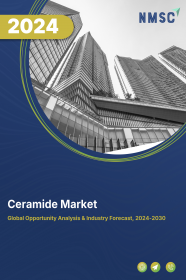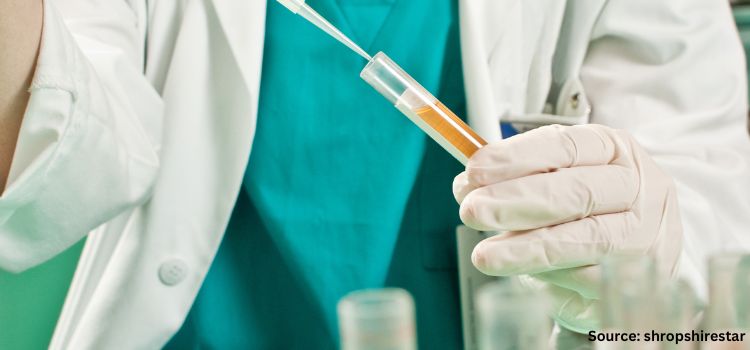
Ceramide Market by Type (Natural and Synthetic), by Process (Fermentation Ceramide and Plant Extract), by Application (Cosmetics, Pharmaceutical, Food, Petcare, and Others), and by Distribution Channel (Cosmetics Shop, Pharmacy, Online, and Others)- Global Opportunity Analysis and Industry Forecast 2022-2030
US Tariff Impact on Ceramide Market
Trump Tariffs Are Reshaping Global Business
Market Definition
The Ceramide Market size was valued at USD 395.2 Million in 2023 and is predicted to reach USD 567.6 Million by 2030 with a CAGR of 5.3% from 2024-2030. Ceramide is a component of vernix caseosa, the waxy or cheese-like white substance found coating the skin of new-born human infants. It is a type of lipid complex that is present in intercellular spaces of the epidermis layer of skin.
Ceramide is also found in plants such as Glycosphingolipids that contain ceramide compounds and it consists of fatty acid & sphingosine. Ceramide can be either natural or synthetic. Natural ceramide is extracted from several plants such as wheat, rice, and soybeans, whereas, synthetic ceramide is formed through microbial fermentation of microorganisms.
Ceramide products are widely used in pet care and skincare items. It also helps in skin hydration, moisturizing ratio, and prevents dryness & irritation. Ceramides are also being explored as a potential therapeutic in treating cancer cells.
Market Dynamics and Trends
Increasing demand for cosmetics, skincare, and beauty products along with the aging population across the world is expected to drive the growth of the ceramide market, as ceramide helps to treat skin conditions that include eczema and psoriasis.
In addition, rising awareness of e-commerce and online sales is expected to further propel the ceramidamide market share. Moreover, rapid surge in the pharmaceutical industry coupled with the increase in various skin problems such as skin damage, dry skin xerosis & xeroderma accelerates the market growth.
Furthermore, rise in the pollution level and global warming have pushed the population toward organic ceramide products that are further expected to drive the growth of the ceramide industry, during the forecast period.
However, the negative impact on metabolism due to the excessive use of ceramides such as diabetes and cardiovascular are expected to restrain the growth of the sphingolipid market during the forecast period.
On the contrary, the growing availability of ceramide oral supplements that are derived from plants helps to improve skin health, boost barrier function & hydration, protect against harmful UV rays, and rejuvenate aging skin, which is expected to create ample growth opportunities for the sphingosine-1-phosphate market in the coming years.
Market Segmentations and Scope of the Study
The ceramide market is segmented on the basis of type, process, application, distribution channel, and geography. On the basis of type, the market is divided into natural and synthetic. On the basis of process, the market is classified into fermentation ceramide and plant extract. On the basis of application, the market is categorized into cosmetics, pharmaceuticals, food, pet care, and others. On the basis of distribution channel, the market is segmented into cosmetics shops, pharmacy, online, and others. Geographic breakdown and analysis of each of the aforesaid segments includes regions comprising North America, Europe, Asia-Pacific, and RoW.
Geographical Analysis
Asia-Pacific holds the lion’s share of the ceramide industry, and is expected to continue its dominance during the forecast period. This is attributed to emerging economies along with high disposable income in several countries such as China, India, and Vietnam that influenced individuals toward ceramide skincare and cosmetics products.
Also, the heavy Foreign Direct Investment (FDI) investments, mainly in the countries such as India, China, and Indonesia enhance the R&D and innovation in ceramide, boosting the market growth in this region. For instance, in December 2019, CeraVe launched a cleanser and serum containing ceramide for treating pimples that also helps to reduce the appearance of post-acne marks and prevents the appearance of fine lines and wrinkles.
On the other hand, North America is expected to show a steady rise in the ceramide market, owing to the development of supermarket & hypermarket stores in countries such as the US and Canada aiming to capture potential consumers. For instance, well-known supermarkets including Walmart Inc. and T&T Supermarket are involved in selling several ceramide products such as moisturizers, lotions, capsules, and more.
The products include Equate Beauty PM Ceramide Moisturizing Facial Lotion and Elizabeth Arden Ceramide Capsules Daily Youth Restoring Face Serum. In addition, the growth of vegan cosmetics such as Pacifica Beauty’s 100% vegan ceramide barrier repair under eye cream and Pacifica Beauty’s vegan ceramide barrier face lotion on the platforms like Amazon is influencing the adoption of artificially created ceramide without the utilization of animal by-products, which is further expected to drive the ceramidamide market growth in this region.
Competitive Landscape
The ceramide industry includes various market players such as Evonik, Macrocare Tech Ltd, Doosan Corporation, Sederma, Cayman Chemical, Xi’an Aladdin Biological Technology, Incospharm Corporation, Kao Group, Ashland Inc., Anderson Global Group LLC, Pioneer Biotech. These market players are adopting several strategies such as product launches and acquisitions across various regions to maintain their dominance in the industry.
For instance, in November 2021, Evonik expanded its ceramide products line with launch of several ceramide products including SPHINOX Defenda, SPHINOX Lift, SK-INFLUX Evolve MB, and RHEASOME CeraBoost. These products are based on a combination of a natural, biotech-derived delivery system with active ingredients that are capable of boosting the skin's ceramide synthesis and replenishing skin lipids from within.
Moreover, in July 2019, Arkema S.A., French advanced materials and specialty chemicals acquired Arr-Maz Custom Chemicals, Inc., an American prominent specialty chemical producer. This acquisition is expected to diversify the product portfolio including ceramide products and widen the reach of the French specialty chemical manufacturer.
Key Benefits
-
The ceramide market report provides a quantitative analysis of the market estimations through 2022-2030 that assists in identifying the prevailing market opportunities to capitalize on.
-
The study comprises a deep dive analysis of the ceramide market including the current and future trends for depicting the prevalent investment pockets in the industry.
-
The information related to key drivers, restraints, and opportunities and their impact on the market is provided in the report.
-
The competitive analysis of the market players along with their revenue in the ceramide market.
-
The SWOT analysis and Porters Five Forces model are elaborated in the study.
-
Value chain analysis in the market study provides a clear picture of the stakeholders’ roles.
Ceramide Market Key Segments
By Type
-
Natural
-
Synthetic
By Process
-
Fermentation Ceramide
-
Plant Extract
By Application
-
Cosmetics
-
Pharmaceutical
-
Food
-
Petcare
-
Others
By Distribution Channel
-
Cosmetics Shop
-
Pharmacy
-
Online
-
Others
By Geography
-
North America
-
U.S
-
Canada
-
Mexico
-
-
Europe
-
UK
-
Germany
-
France
-
Italy
-
Spain
-
Rest of Europe
-
-
Asia-Pacific
-
China
-
India
-
Japan
-
South Korea
-
Australia
-
Rest of Asia-Pacific
-
-
RoW
-
UAE
-
Saudi Arabia
-
South Africa
-
Brazil
-
Remaining countries
-
Key Players
-
Evonik
-
Macrocare Tech Ltd
-
Doosan Corporation
-
Sederma
-
Cayman Chemical
-
Pioneer Biotech
-
Incospharm Corporation
-
Unitika
-
Kao Group
-
Ashland Inc.
-
Anderson Global Group LLC
REPORT SCOPE AND SEGMENTATION:
|
Parameters |
Details |
|
Analysis Period |
2023–2030 |
|
Base Year Considered |
2023 |
|
Forecast Period |
2024–2030 |
|
Market Size Estimation |
Million (USD) |
|
Market Segmentation |
By Type (Natural and Synthetic), by Process (Fermentation Ceramide and Plant Extract), by Application (Cosmetics, Pharmaceutical, Food, Petcare, and Others), and by Distribution Channel (Cosmetics Shop, Pharmacy, Online, and Others) |
|
Geographical Segmentation |
North America (U.S., Canada, Mexico) Europe (UK, Germany, France, Italy, Spain, Rest of Europe), Asia-Pacific (China, India, Japan, South Korea, Australia, Rest of Asia-Pacific), Rest of the World (UAE, Saudi Arabia, South Africa, Brazil, Remaining countries) |
|
Companies Profiled |
Evonik, Macrocare Tech Ltd, Doosan Corporation, Sederma, Cayman Chemical, Xi’an Aladdin Biological Technology, Incospharm Corporation, Kao Group, Ashland Inc., Anderson Global Group LLC, and Pioneer Biotech. |

















 Speak to Our Analyst
Speak to Our Analyst





















